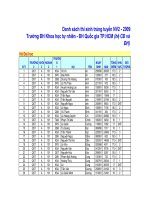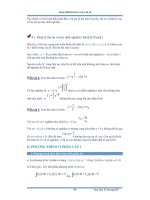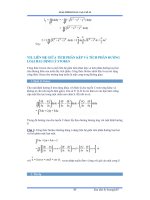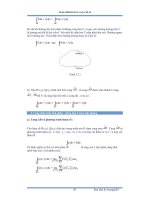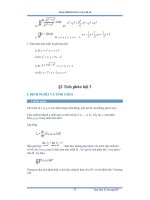Giáo trình ngữ nghĩa học tiếng anh
Bạn đang xem bản rút gọn của tài liệu. Xem và tải ngay bản đầy đủ của tài liệu tại đây (1.55 MB, 252 trang )
ĐẠI HỌC QUỐC GIA THÀNH PHỐ HỒ CHÍ MINH
TRƯỜNG ĐẠI HỌC KHOA HỌC XÃ HỘI VÀ NHÂN VĂN
Tô Minh Thanh
GIÁO TRÌNH
NHÀ XUẤT BẢN ĐẠI HỌC QUỐC GIA
TP HỒ CHÍ MINH
LỜI NÓI ĐẦU
Giáo trình Ngữ nghóa học tiếng Anh được biên soạn một
cách có hệ thống, dựa trên cơ sở tham khảo có chọn lọc những tư
liệu của nước ngồi, kết hợp với kinh nghiệm giảng dạy nhiều năm
về mơn học này của tác giả và tập thể giảng viên trong Bộ mơn Ngữ
học Anh. Đây là tập giáo trình được biên soạn dùng để giảng dạy
mơn học Ngữ nghĩa học tiếng Anh (English Semantics) cho sinh
viên năm thứ tư Khoa Ngữ văn Anh, Trường Đại học Khoa học Xã
hội và Nhân văn, Đại học Quốc gia Thành phố Hồ Chí Minh.
Giáo trình gồm bốn phần:
1.
2.
3.
4.
Introduction (phần dẫn nhập)
Word meaning (nghóa của từ);
Sentence meaning (nghóa của câu);
Utterance meaning (nghóa của phát ngôn)
Lần đầu tiên biên soạn giáo trình này, chúng tơi khơng tránh
khỏi những sai sót, những khuyết điểm. Rất mong nhận được nhiều
ý kiến đóng góp của bạn đọc và của bạn bè đồng nghiệp để giáo
trình ngày càng hồn thiện hơn, phục vụ giảng dạy sinh viên đạt chất
lượng tốt hơn. Ý kiến đóng góp về tập giáo trình này xin gửi về Hội
đồng Khoa học Khoa Ngữ văn Anh, Trường Đại học Khoa học Xã
hội và Nhân văn, Đại học Quốc gia Thành phố Hồ Chí Minh, số 1012 Đinh Tiên Hồng Quận 1, Thành phố Hồ Chí Minh. Điện thoại:
(08)8243328.
Tô Minh Thanh
iii
Thuvientailieu.net.vn
CONTENTS
Preface ....................................................................................... iii
Contents .......................................................................................v
Notational symbols ................................................................... vii
1 INTRODUCTION...................................................................... 9
1.1 What is semantics? ......................................................... 9
1.2 Semantics and its possible included aspects ............. 10
2 WORD MEANING .................................................................. 12
2.1 Semantic features ........................................................ 12
2.2 Componential analysis .................................................. 20
2.3 Semantic fields ............................................................. 21
2.4 Lexical gaps .................................................................... 25
2.5 Referent, reference and sense ................................. 26
2.6 Denotation and connotation ........................................ 30
2.7 Multiple senses of lexical items ................................ 34
2.8 Figures of speech ................................................... 36
2.9 Hyponymy ................................................................ 57
2.10 Synonymy .............................................................. 63
2.11 Antonymy .............................................................. 67
2.12 Homonymy ............................................................. 72
2.13 Polysemy ................................................................ 78
v
Thuvientailieu.net.vn
2.14 Ambiguity .............................................................. 81
2.15 Anomaly ................................................................. 87
3 SENTENCE MEANING ............................................... 91
3.1 Proposition, utterance and sentence ........................ 91
3.2 Sentence types (classified according to
truth value) .............................................................. 96
3.3 Paraphrase .............................................................. 99
3.4 Entailment ............................................................. 104
4 UTTERANCE MEANING .................................................... 109
4.1 Presupposition ...................................................... 109
4.2 Conversational implicature ................................... 128
4.3 Conventional implicature ...................................... 145
4.4 Speech acts .................................................................. 146
4.5 Performatives and constatives ............................ 165
4.6 Politeness, co-operation and indirectness ............ 171
4.7 Deixis .................................................................... 173
Answer keys ............................................................................177
List of English-Vietnamese equivalent linguistic terms .......227
Bibliography ............................................................................252
vi
Thuvientailieu.net.vn
NOTATIONAL SYMBOLS
Most of the symbols used in this text follow conventions, but
since conventions vary, the following list indicates the meanings
assigned to them here.
A: adjunct
AdjP: adjective phrase
AdvP: adverb phrase
C: countable
dO: direct object
Ex: example
mono-trans: mono-transitive verb
n: noun
NP: noun phrase
op: optional
opA of Means: optional adjunct of means
Pro: pronoun
PP: prepositional phrase
RP: Received Pronunciation
S: sentence
Vgrp: verb group
VP: verb phrase
* : unaccepted form
iv
Thuvientailieu.net.vn
-- : related in some way
[ ] : embedded unit
/ : or
⇒ : one-way dependence
⇔ : two-way dependence
= : be equivalent to
+ : with the semantic feature specified
− : without the semantic feature specified
± : with or without the semantic feature specified
v
Thuvientailieu.net.vn
Section
1
INTRODUCTION
1.1 What is semantics?
Semantics is a branch of linguistics which deals with
meaning. In order to understand this definition, we need to know what
meaning is. However, before we discuss the “meaning” of meaning, it
is necessary to talk about the main branches of linguistics.
Linguistics has three main branches: syntax, semantics and
pragmatics. Syntax is the study of grammar (consisting of
phonology, morphology, syntax, and textual grammar)
whereas semantics and pragmatics deal with meaning.
Semantics is the study of meaning in language (i.e. what language
means) while pragmatics is concerned with meaning in context
(i.e. what people mean by the language they use). Although this is
a semantics course, part of what we are going to discuss is
concerned with pragmatics, for semantics and pragmatics are
closely related.
Take the distinction between semantic meaning and pragmatic
meaning as an illustration of how semantics is different from but, at
the same time, closely related to pragmatics.
Semantic meaning is context-free whereas pragmatic meaning
is context-dependent.
(1) A: ‘Would you like a piece of cake?’
B: ‘I’m on a diet.’
9
Thuvientailieu.net.vn
The semantic meaning of ‘I’m on a diet’ in (1) is ‘I want to
lose weight by eating the food which is not rich in fat, sugar, etc.’
The pragmatic meaning of ‘I’m on a diet’ in (1) is ‘I don’t want
any piece of cake’ or ‘I’m afraid that I have to refuse your invitation.’
(2) Tom: ‘Do you like the wine I picked out?’
Gina: ‘It’s Italian, isn’t it?’
The semantic meaning of ‘It’s Italian, isn’t it?’ in (2) is ‘Is it
right that the wine is made in Italy?’
The pragmatic meaning of ‘It’s Italian, isn’t it?’ in (2) is ‘I
don’t like the wine you picked out.’
1.2 Semantics and its possible included aspects
“Semantics is a technical term used to refer to the study of
meaning, and since meaning is part of language, semantics is
part of linguistics. Unfortunately, ‘meaning’ covers a variety of
aspects of language, there is no general agreement about the
nature of meaning, what aspects of it may properly be
included in semantics, or the way in which it should be
described.” [Palmer, 1981: 1] This little textbook will try to show
three main aspects that are commonly considered as included in
semantics: word meaning (or, to be more precise, lexical
meaning) [Lyons, 1995: 33], sentence meaning and utterance
meaning.1
In semantics it is necessary to make a careful distinction between utterances
and sentences. In particular we need some way of making it clear when we are
1
discussing sentences and when utterances. We adopt the convention that anything
10
Thuvientailieu.net.vn
The meaning of remarried, for example, can be analysed in
the three different levels.
At the word level, remarried may be regarded a set of the
four following semantic features: [+human], [±male], [+used to
be married], and [+married again].
At the sentence level when remarried occurs in She is not
remarried, only the fourth semantic feature of the word,
namely [+married again], is informative, i.e. it is part of the
statement.
At the utterance level within the particular context of the
following conversation when remarried occurs in B’s response, it
is the word that helps the utterance presuppose that pastors are
allowed by rule to get married and implicate that the pastor was
once married.
A: ‘How is the pastor?’
B: ‘He is remarried.’
Because of the nature of the subject and the variety of views
on semantics and its possible included aspects, the little
textbook cannot hope to be more than an introductory survey.
written between single quotation marks represents ‘an utterance’, and
anything italicized represents a sentence or (similarly abstract) part of a
sentence, such as a phrase or a word:
‘She is not remarried’ represents an utterance.
She is not remarried represents a sentence.
Married represents a word conceived as part of a sentence.
11
Thuvientailieu.net.vn
Section
2
WORD MEANING
WORD MEANING is what a word means, i.e. “what counts as
the equivalent in the language concerned.” [Hurford and Heasley,
1984: 3]
2.1 Semantic features
2.1.1 Definition
Semantic features2 are “the smallest units of meaning in a
word.” [Richards et al, 1987: 254]
We identify the meaning of a word by its semantic
features. For example, father may have the following semantic
features: [+human], [+male], [+mature], [+parental] and
[+paternal]. And hen may be described as a set of the following
semantic features: [+animate], [+bird], [+fowl], [+fully grown]
and [+female].
2.1.2 Characteristics
2.1.2.1 Some semantic features need not be specifically
mentioned. For example, if a word is [+human] it is
“automatically” [+animate]. This generalization can be expressed
as a redundancy rule:
2
Semantic features are also referred to as semantic components or semantic
properties.
12
Thuvientailieu.net.vn
A word that is [+human] is [+animate].
That is why [+animate] need not be specified as a semantic
feature of father, girl, professor, etc. since the semantic feature
can be inferred from [+human].
Some redundancy rules infer negative semantic
features. Thus, semantic features are often shown in the form of
binary oppositions, which can be stated in terms of pluses and
minuses (that is, [+] and [−
−]):
If father is [+human], it is therefore [−
−inhuman];
If father is [+male], it is therefore [−
−female];
If father is [+mature], it is therefore [−
−immature];
−maternal].
If father is [+paternal], it is therefore [−
Notice that we identify the meaning of a word according to its
primitive semantic features first, e.g. [+animate], [+human],
[+male], etc.; and then with the assistance of its other semantic
features, e.g. [+parental], [+paternal], etc.
2.1.2.2 Different words may share the same semantic
feature. In other words, the same semantic feature can be
found in many different words.
Ex1: Doctor, engineer, teacher, physicist, chemist,
tailor, hairdresser, etc. all share the same semantic feature
[+professional].
Ex2: Mother, father, son, daughter, brother, sister,
grandparent, aunt, uncle, etc. are all [+kinship].
13
Thuvientailieu.net.vn
2.1.2.3 The same semantic feature can occur in words of
different parts of speech. In other words, words of different
parts of speech may share the same semantic feature.
For example, [+female] is part of the meaning of the noun
mother, the verb breast-feed and the adjective pregnant. And
[+educational] is a semantic feature found in the nouns school,
teacher, textbook, etc. and in the verbs teach, educate,
instruct, etc.
2.1.2.4 Fromkin and Rodman [1993: 148-149] confirm that
“the semantic properties of words determine what other
words they can be combined with.” These authors give the two
following sentences that are grammatically correct and
syntactically perfect but semantically anomalous:
(1) My brother is an only child.
(2) The bachelor is pregnant.
(1) is strange, or semantically anomalous, because this
sentence represents a contradiction: brother is [+having at least
one sibling] while an only child is [+having no other sibling];
(2) is semantically anomalous for a similar reason: bachelor is
[+male] whereas pregnant is [+female].
Here, Fromkin and Rodman also cite Noam Chomsky’s famous
classic example of semantically anomalous sentences:
(3) Colorless green ideas sleep furiously.
This sentence seems to obey all the syntactic rules of English:
its subject is colorless green ideas and its predicate is sleep
furiously; but there is obviously something semantically wrong
14
Thuvientailieu.net.vn
with the sentence. The adjective colorless is [−
−colour], but it
occurs with the adjective green the semantic feature of which
[+green in colour]. How can something be [−
−colour] and [+green
in colour] at the same time? In the same way, the noun ideas,
which is [+abstract], is semantically incompatible with the verb
sleep the noun phrase subject of which must be [+concrete] and
[+animate]. How can an abstract notion like ideas sleep? Then,
the verb sleep, whose adverbial collocations3 are well, badly and
soundly, is semantically incompatible with the adverb furiously.
How can a living being sleep when he is full of violent anger?
In conclusion, knowing all the possible semantic features of a
word enables us to combine semantically compatible words
together to form larger but meaningful linguistic units such as
phrases, clauses and sentences.
Fromkin and Rodman [1993:134] also believe that “because
we know the semantic properties of words, we know when two
words are antonyms, synonyms or homonyms, or are unrelated
in meaning.”
Exercise 1: For each group of words given below, state what
semantic features are shared by the (a) words and the (b)
words, and what semantic features distinguish between the
classes of (a) words and (b) words. The first one is done as an
example.
Collocations are regular combinations of words, e.g. by accident and strong tea
are English collocations.
Adverbial collocations refer to the adverbs regularly used together with a certain
verb.
3
15
Thuvientailieu.net.vn
1. (a) lobster, shrimp, crab, oyster, mussel
(b) trout, sole, herring, salmon, mackerel
The (a) and (b) words are [+edible water animal].
The (a) words are [+shellfish].
The (b) words are [+fish].
2. (a) widow, mother, sister, aunt, seamstress
(b) widower, father, brother, uncle, tailor
The (a) and (b) words are ___________________________
The (a) words are _________________________________
The (b) words are __________________________________
3. (a) bachelor, son, paperboy, pope, chief
(b) bull, rooster, drake, ram, stallion
The (a) and (b) words are ___________________________
The (a) words are __________________________________
The (b) words are _________________________________
4. (a) table, pencil, cup, house, ship, car
(b) milk, tea, wine, beer, water, soft drink
The (a) and (b) words are ____________________________
The (a) words are __________________________________
The (b) words are __________________________________
5. (a) book, temple, mountain, road, tractor
(b) idea, love, charity, sincerity, bravery, fear
16
Thuvientailieu.net.vn
The (a) and (b) words are ____________________________
The (a) words are __________________________________
The (b) words are __________________________________
6. (a) rose, lily, tulip, daisy, sunflower, violet
(b) ash, oak, sycamore, willow, beech
(c) pine, cedar, jew, spruce, cypress
The (a) (b) and (c) words are _________________________
The (a) words are __________________________________
The (b) words are __________________________________
The (c) words are __________________________________
7. (a) book, letter, encyclopaedia, novel, notebook, dictionary
(b) typewriter, pencil, ballpoint, crayon, quill, charcoal, chalk
The (a) and (b) words are ____________________________
The (a) words are __________________________________
The (b) words are __________________________________
8. (a) walk, run, skip, jump, hop, swim
(b) fly, skate, ski, ride, cycle, canoe, hang-glide
The (a) and (b) words are ____________________________
The (a) words are __________________________________
The (b) words are __________________________________
9. (a) ask, tell, say, talk, converse
(b) shout, whisper, mutter, drawl, holler
17
Thuvientailieu.net.vn
The (a) and (b) words are ____________________________
The (a) words are __________________________________
The (b) words are __________________________________
10. (a) alive, asleep, awake, dead, half-dead, pregnant
(b) depressed, bored, excited, upset, amazed,
surprised
The (a) and (b) words are ____________________________
The (a) words are __________________________________
The (b) words are __________________________________
Exercise 2: Identify the semantic features in each of the
following words.
1. Child: _____________________________________________
2. Aunt: ____________________________________________
3. Hen: _____________________________________________
4. Oak (-tree): ______________________________________
5. Flower: ___________________________________________
6. Palm: _____________________________________________
7. Bachelor: _________________________________________
8. Actress: __________________________________________
9. Plod: _____________________________________________
10. Ewe:_____________________________________________
11. Fly: _____________________________________________
18
Thuvientailieu.net.vn
12. Stallion: _________________________________________
13. Police-officer: ___________________________________
14. Beauty: __________________________________________
15. Imagine: _________________________________________
16. Doe: ____________________________________________
17. Drive: ___________________________________________
18. Home: __________________________________________
19. Elm: ____________________________________________
20. Chalk: ___________________________________________
21. Rose: ____________________________________________
22. Chick: ___________________________________________
23. Pap: _____________________________________________
24. Tiptoe: __________________________________________
25. Pine (-tree): _____________________________________
26. Owe: ____________________________________________
27. Computer: _______________________________________
28. Honesty: ________________________________________
29. Maid: ___________________________________________
30. Spinster: ________________________________________
Exercise 3: How can you distinguish the words given in the
following table from one another, considering their semantic
features?
19
Thuvientailieu.net.vn
Malay
English
brother
sadara
Vietnamese
Chinese
anh
huynh
em
sister
chò
ñeä
muoäi
tyû
____________________________________________________
____________________________________________________
____________________________________________________
____________________________________________________
____________________________________________________
____________________________________________________
2.2 Componential analysis
In Semantics, componential analysis is “an approach to the
study of meaning which analyses a word into a set of
meaning components or semantic features.” [Richards et al,
1987: 53]
For example, the meaning of boy may be shown as [+human],
[+male] and [−adult] while that of man may be a combination of
[+human], [+male] and [+adult]. Thus, man is different from boy
basically in one primitive semantic feature: [±adult].
20
Thuvientailieu.net.vn
Generally speaking, componential analysis is applied to a
group of related words which may differ from one another only
by one or two semantic features.
2.3 Semantic fields
2.3.1 Definition
A semantic field4 is “the organization of related words
and expressions into a system which shows their
relationship to one another.” [Richards et al, 1987: 53]
A semantic field can also be defined as “a set of words with
identifiable semantic affinities.” [Finegan, 1994: 164]
Ex1. The semantic field of kinship terms: father, mother,
brother, sister, uncle, aunt, etc.
Ex2. The semantic field of adjectives describing human
emotional states: angry, sad, happy, exuberant,
depressed, afraid, etc.
Ex3. The semantic field of drinking vessels: cup, mug,
tumbler, wine glass, beer glass, etc.
2.3.2 Ways of organising semantically similar items into
semantic fields
There are various ways according to which semantically
similar items are related to one another:
(a) Items related by topics:
4
A semantic field is also referred to as a lexical field or a lexical set.
21
Thuvientailieu.net.vn
• Types of fruit: apples, oranges, grapes, bananas, pears,
plums, etc.
• Pieces of furniture: seats, tables, beds, storage, etc.
• Terms of colour: blue, red, yellow, green, black, white, etc.
(b) Items similar in meaning:
• Ways of cooking: stew, boil, fry, steam, roast, grill, smoke,
etc.
• Ways of looking5: gaze, glance, peer, squint, stare, etc.
• Ways in which a liquid escapes from its container6: drip,
leak, ooze, run, seep, etc.
5
Gaze = look long and steadily (at somebody/something) usually in surprise or
admiration: She gazed at me in disbelief when I told her the news.
Glance = take a quick look at: She glanced shyly at him and then lowered her eyes.
Peer (at, through, up, etc,) = look closely and carefully, especially as if unable to see
well: peer at somebody, peer out of the window, peer over the wall, peer through
the gap, peer over one’s spectacles, etc.
Squint (at, through, up, etc,) = look (at somebody/something) with eyes half shut or
turn sideways, or through narrow opening: squint in the light of sunshine, squint
through the letter box.
Stare = look (at somebody/something) with the eyes wide open in a fixed gaze (in
astonishment, wonder, fear, etc.): They all stared in/with amazement. It’s rude to stare.
6
Drip (allow liquid to) fall in drops: Rain was dripping down from the trees. Is that
roof still dripping?
Leak (allow liquid or air to) get in or out wrongly: The boat leaks like a sieve. Air
leaked out of the balloon.
Ooze (from/out of something; out/away) = (allow a thick liquid to) come or flow out slowly:
Black oil was oozing out of the engine. All the toothpaste has oozed out.
Run = (allow a liquid to) flow: The River Rhine runs into the North Sea. Water was
running all over the bathroom floor. The bathroom floor was running with water.
Seep (through/into/out of something; through/out) = (of a liquid) flow slowly and in small
quantities through a substance: Water seeped through the roof of the tunnel.
22
Thuvientailieu.net.vn
(c) Terms describing people whose weight is below
normal:7 thin, bony, skinny, scrawny, underweight,
emaciated, slender, slim, etc.
(d) Items which form pairs of antonyms: long/short,
light/heavy, alive/dead, love/hate,
approve/disapprove, approve/disapprove, begin/end,
inside/outside, upstairs/downstairs, etc.
Oil is seeping through a crack in the tank.
“Drip, leak, ooze, run, seep indicate the way in which a liquid escape from a
container or tap. Most (not seep) also indicate the way in which a container or tap
allows a liquid to escape. 1 Drip = (allow sth to) fall in regular drops: Water is
dripping from the pipe. The pipe is dripping (water). 2 Leak = (allow sth to) get
out (through a hole in sth): Wine is leaking from the barrel. The barrel is leaking
(wine). 3 Ooze = (allow sth to) move slowly (out of sth) because thick: Blood is
oozing from the wound. The wound is oozing (blood). 4 Run = (allow sth to) flow
continuously (from sth): Water is running from the tap. The tap is running. 5
Seep = move slowly (through a small opening in sth) because thick: Oil is seeping
from the engine.” [Crowther (ed.), 1992: 272]
7
“When describing people whose weight is below normal, thin is the most general word,
It may be negative, suggesting weakness or lack of health: She‘s gone terribly thin
since operation. Bony is often applied to parts of the body such as hands or face;
skinny and scrawny are negative and can suggest lack of strength: He looks much
too skinny/scrawny to be a weight-lifter. Underweight is the most neural: The
doctor says I’m underweight. Emaciated indicates a serious condition resulting from
starvation. It is often thought desirable to be slim or slender, slim being used
especially of those who have reduced their weight by diet or exercise: I wish I was
as slim as you. You have a beautifully slender figure.” [Crowther (ed.), 1992: 947]
23
Thuvientailieu.net.vn
(e) Items which form pairs or trios of synonyms:
smart/bright/intelligent, conserve/preserve/safeguard,
fix/repair/mend, kind/sort/type/variety, happy/glad, etc.
(f) Items grouped as an activity or a process:
• Do the housework: clean the rooms, do the washing, iron
the clothes, get the food, prepare a meal, wash up, etc.
• Do research: make hypotheses, collect data, analyze data,
get results and come to conclusions.
(g) Items classified according to:
Male: waiter, tiger, actor, host, landlord, sir, etc.
• Sex
Female: waitress, tigress, actress, hostess,
landlady, madam, etc.
• Age: grown-ups, adults, elderly people, middle-aged
people, teenagers, children, infants, babies, etc.
• Age and sex:
horse ⇒ stallion:[+male],[+fully grown] dog ⇒ dog: [+male],[+fully grown]
mare:[+female],[+fully grown]
bitch:[+female],[+fully grown]
foal: [±±male], [−−fully grown]
puppy: [±±male], [−−fully grown]
Exercise 4: Organise the given words (and probably those of your
own) into three semantic fields: shirts, end, forward(s), new,
hats, lend, coats, shorts, beginning, trousers, amble, out,
24
Thuvientailieu.net.vn
limp, tiptoe, plod, socks, trudge, borrow, stomp, in, stump,
old, backward(s), and tramp.
1._________________________________________________
__________________________________________________
2._________________________________________________
__________________________________________________
3._________________________________________________
__________________________________________________
2.4 Lexical gaps
“The absence of a word in a particular place in a lexical
field of a language” is called a lexical gap. [Richards et al, 1987:
164]
For example, in English there is no singular noun that covers
bull, cow and calf either as horse covers stallion, mare and foal
or as goat covers billy-goat, nanny-goat and kid.
horse
?
goat
stallion mare foal billy-goat
nanny-goat
kid
bull
cow calf
Exercise 5: Try to fill in each of the two blanks with an
appropriate word to prove that there is no lexical gap in the
given semantic fields.
25
Thuvientailieu.net.vn
sheep
ram ewe
giraffe
male giraffe
baby giraffe
2.5 Referent, reference and sense
2.5.1 Distinction between referent, reference and sense
In Semantics, a distinction is often made between referent,
reference and sense:
2.5.1.1 A referent is an object or an entity in the real
world or in the world of your imagination, e.g. your school,
your classmates, your teacher, any thing you can see in the
classroom right now, the idealistic working conditions you have
ever dreamed of, etc. that is talked about.
Several words, especially the so-called function words8, have
no obvious referents: the, could, in, since, and, etc.
2.5.1.2 The reference of a word9 or a linguistic expression is
the relationship between that word or expression and the thing
(book), the action (read), the event (graduate from university),
the quality (sincerity), etc. it refers to.
It is commonly believed that function words like prepositions (of, in, etc.),
definite and indefinite articles (the, a/an), conjunctions (if, however, or, etc.),
and auxiliaries (may, should, will, etc.) only “signal grammatical relations.”
[Finegan, 1994: 175]
9
Or, to be more precise, a lexical item
8
26
Thuvientailieu.net.vn
For example, the reference of Peter’s house is the
relationship between this English noun phrase and the house that
belongs to Peter.
Peter’s house
the house that belongs to Peter
(in the Eng. language) REFERENCE
(in the real world)
2.5.1.3 The sense10 of a word or a linguistic expression11
shows the internal relationship between that word or expression
and others in the vocabulary of a language.
Ex1. Teacher and student have the sense relationship of the former
is the one who gives a lesson and the latter is the one
who has the lesson given by the former.
Ex2. A dog is chasing a cat has some sense. However, a dog is
human has no sense.
Ex3. The King of Vietnam is bald has some sense: its sense is
constructed by its individual lexical components and its
syntactic structure. However, this sentence has no reference: it
does not refer to any real person because the King of
Vietnam does not exist nowadays.
Consider the following table and identify
reference and sense via their main features.
referent,
It is necessary to notice that the two linguistic terms sense and meaning will be
used interchangeably from now on in this text.
11
“The SENSE of an expression is its indispensable hard core of meaning.”
[Hurford and Heasley, 1984: 91]
10
27
Thuvientailieu.net.vn

